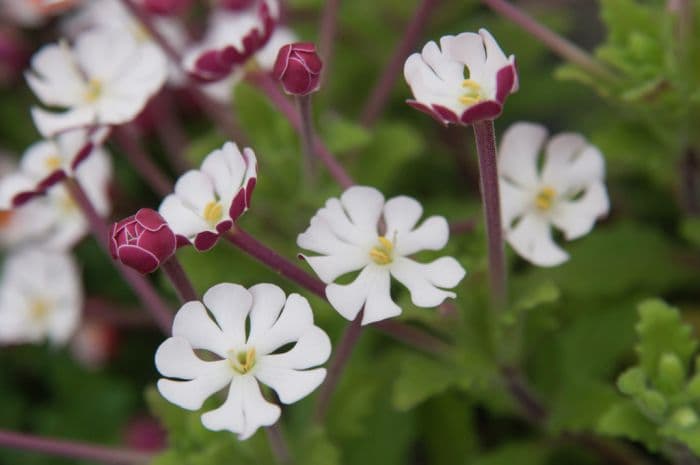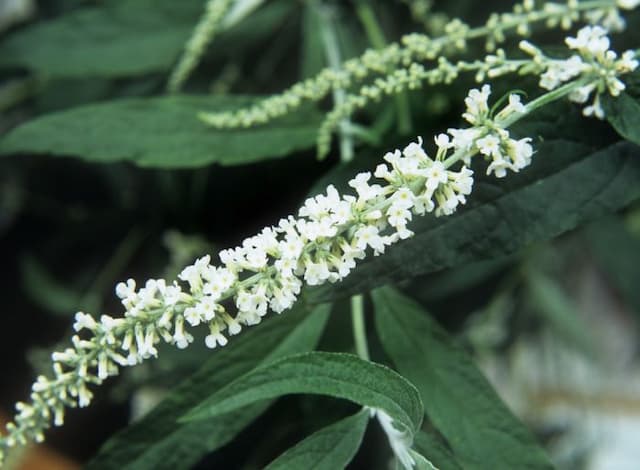Night Phlox Zaluzianskya ovata

ABOUT
Zaluzianskya ovata, commonly known as night phlox, is a plant with a distinctive appearance. It typically bears green, spoon-shaped leaves that form a dense mound or carpet-like formation. The foliage tends to be lush, providing a rich backdrop for the blooms. The night phlox is famous for its flowers which have a unique pattern of blooming; they open during the evening, emitting a delightful fragrance that is most notable at night. These flowers are stark white on the inside with a contrasting maroon reverse, giving them a two-toned effect when viewed from different angles. The blossoms are small, tubular, and arranged in clusters, which gives the impression of a delicate, starry appearance when they are in full bloom. The petals are narrow and elongate, converging to form the characteristic tubular shape. During the day, the flowers close up, revealing the maroon coloring of the reverse side more prominently and adding a different color aspect to the overall plant appearance. Overall, the night phlox has an enchanting look, with its contrasting white and maroon flowers emerging from the dense greenery, and is especially noted for the striking transformation it undergoes between day and night.
About this plant
 Names
NamesFamily
Scrophulariaceae
Synonyms
Night Phlox, Midnight Candy
Common names
Zaluzianskya ovata
 Toxicity
ToxicityTo humans
Night Phlox (Zaluzianskya ovata) is not widely known to be toxic to humans. Most sources do not report this plant as being poisonous, and there is limited information on human poisoning from it. Therefore, if there is any potential toxicity, it appears to be low or not well documented. As always, consuming any plant matter that is not known to be edible carries risks, and it's generally advised not to eat ornamental plants due to the potential for unknown toxicities or contaminants.
To pets
Night Phlox (Zaluzianskya ovata) is not commonly listed as a toxic plant to pets such as dogs and cats. Most sources do not report any known toxicity of Night Phlox to animals, and there is little available information to suggest it poses a significant risk. Therefore, it appears to be safe for pets, although it is always wise to prevent pets from ingesting plants as they might cause gastrointestinal upset or an unexpected allergic reaction.
 Characteristics
CharacteristicsLife cycle
Perennials
Foliage type
Evergreen
Color of leaves
Green
Flower color
White
Height
1 foot (0.3 meters)
Spread
1 foot (0.3 meters)
Plant type
Shrub
Hardiness zones
9
Native area
South Africa
Benefits
 General Benefits
General Benefits- Ornamental Appeal: Zaluzianskya ovata, commonly known as night phlox, boasts attractive white and maroon flowers that add aesthetic value to gardens and landscapes.
- Fragrance: Night phlox emits a sweet fragrance at night, which adds a sensory dimension to garden spaces after dusk.
- Attracts Pollinators: The flowers of night phlox attract nocturnal pollinators such as moths, which can aid in the pollination of other plants in the garden.
- Low Maintenance: Night phlox is known for requiring relatively low levels of maintenance, making it suitable for gardeners of all skill levels.
- Drought Tolerance: Once established, night phlox exhibits a degree of drought tolerance, reducing the need for frequent watering.
- Compact Size: With its compact growth habit, night phlox is ideal for small gardens, borders, and containers, allowing it to fit into various garden designs.
 Medical Properties
Medical PropertiesThis plant is not used for medical purposes.
 Air-purifying Qualities
Air-purifying QualitiesThis plant is not specifically known for air purifying qualities.
 Other Uses
Other Uses- Zaluzianskya ovata, commonly known as Night Phlox, can be used as an ornamental addition to moon gardens where its white flowers will stand out in the nighttime.
- Night Phlox's ability to emit a fragrant scent in the evening can create a pleasant atmosphere for outdoor dining or entertainment areas after dark.
- This plant can be included in sensory gardens designed to stimulate the senses, especially smell, with its strong evening fragrance.
- Night Phlox can be used to create living borders or edges for garden pathways, releasing its scent as people brush past.
- Due to its compact size, Night Phlox is suitable for container gardening, making it ideal for balconies and small patios.
- This plant's attractive foliage and flowers can be used in floral arrangements or as garnish for plates in culinary presentations.
- Night Phlox can serve as a natural indicator of the time of day, as its flowers open in the evening and close in the morning.
- The plant can be incorporated into educational gardens to illustrate plant responses to light, such as nyctinasty, to students and gardening enthusiasts.
- Night Phlox can be planted in pet-friendly garden areas, as it is not known to be toxic to dogs or cats.
- Zaluzianskya ovata can be used in wedding ceremonies, placed strategically for its evening bloom and fragrance to enhance the night-time celebration.
Interesting Facts
 Feng Shui
Feng ShuiThe Night Phlox is not used in Feng Shui practice.
 Zodiac Sign Compitability
Zodiac Sign CompitabilityThe Night Phlox is not used in astrology practice.
 Plant Symbolism
Plant Symbolism- Beauty and Delight: Commonly known as "night phlox," Zaluzianskya ovata opens its flowers at dusk with a sweet fragrance, symbolizing the beauty and joy that can be found in the tranquil moments of life.
- Mystery and Secrets: Given its unique characteristic of only revealing its scented, white blooms under the veil of night, night phlox is often associated with the mysterious and the secretive aspects of nature.
- Adaptation: As the night phlox adapts to the cooler temperatures of night to bloom, it represents the ability to adapt and thrive in differing conditions.
- Balance: The plant's method of balancing its growth between day and night can symbolize the importance of balance in our own lives.
 Water
WaterThe Night Phlox, or Zaluzianskya ovata, should be watered thoroughly, allowing the water to drain completely through the pot. In general, watering should occur when the top inch of soil feels dry to the touch, which may be about once a week depending on environmental conditions; however, in higher temperatures and during active growth periods, it may need more frequent watering. Ensure that the plant receives approximately one gallon of water at each watering session, but be careful not to overwater as this can lead to root rot. During the winter months, reduce watering frequency to prevent waterlogging of the dormant plant.
 Light
LightNight Phlox thrives in full sun to partial shade conditions. It should be placed in a spot where it can receive at least six hours of sunlight a day. Avoiding intense afternoon sun can help prevent leaf scorch, so a position with morning sunlight and some afternoon dappled shade would be ideal for this plant.
 Temperature
TemperatureNight Phlox prefers moderate temperatures and can survive in a range where the minimum temperature doesn't drop below 50 degrees Fahrenheit and the maximum doesn't exceed 80 degrees Fahrenheit. The ideal temperature range for promoting healthy growth is between 60 and 75 degrees Fahrenheit. Protect the plant from frost, as cold temperatures below the minimum threshold can damage or kill it.
 Pruning
PruningPrune Night Phlox to maintain its shape and promote bushier growth by cutting back leggy stems. Pruning is best done in the early spring before new growth starts. Remove any dead or damaged foliage as needed to keep the plant healthy. Trimming back after the first flush of flowers can encourage a second bloom. Pruning should be done lightly and not more than once or twice a year to avoid stressing the plant.
 Cleaning
CleaningAs needed
 Soil
SoilNight phlox (Zaluzianskya ovata) thrives in well-draining soil with a mix of loam, peat, and sand, with a slightly acidic to neutral pH of 6.0 to 7.0.
 Repotting
RepottingNight phlox should be repotted every 2-3 years or when the plant has outgrown its current pot.
 Humidity & Misting
Humidity & MistingNight phlox prefers moderate to high humidity levels but is adaptable to average room humidity as well.
 Suitable locations
Suitable locationsIndoor
Provide bright light, cool temps, and fresh airflow for indoor night phlox.
Outdoor
Plant night phlox in partial shade with shelter from strong winds.
Hardiness zone
9-11 USDA
 Life cycle
Life cycleZaluzianskya ovata, commonly known as night phlox, begins its life cycle as a seed, which, under appropriate conditions of warmth and moisture, germinates and develops a root system and a shoot that emerges from the soil. As a seedling, night phlox prioritizes root establishment and the growth of a few leaves to harness energy from sunlight through photosynthesis. As it progresses into the vegetative stage, it develops a rosette of leaves, growing fuller and bushier, and it may remain in this stage for an extended period depending on environmental conditions. Upon reaching maturity, it enters the flowering stage, producing fragrant white and maroon flowers that open at night and close during the day, which are pollinated by nocturnal insects. After successful pollination, the flowers develop into seed capsules, filled with seeds that, when mature, are dispersed by wind or other mechanical means. The plant completes its life cycle when it dies after seeding, which can occur after a few years since night phlox is a perennial species.
 Propogation
PropogationPropogation time
Spring-Early Summer
Propogation: Night Phlox (Zaluzianskya ovata) is most commonly propagated through seed sowing. The suitable time for sowing seeds is in late winter to early spring when the danger of frost has passed, which allows for a full growing season. You should sow the seeds in well-draining soil in a flat or a pot and lightly cover them with a thin layer of soil. The medium should be kept moist but not waterlogged, and the container should be placed in a warm location with plenty of indirect light. Germination typically occurs within two to three weeks, after which seedlings can be carefully transplanted to individual pots once they're large enough to handle. It's crucial not to disturb the roots too much during transplantation to ensure successful establishment of the young plants.
![Butterfly bush [Buzz Magenta]](/_next/image?url=https%3A%2F%2Fplants-admin.emdemapps.com%2Fimages%2Fplants%2F%2Fimages%2F604b58e34126b.png&w=640&q=75)
![Butterfly bush [Peacock]](/_next/image?url=https%3A%2F%2Fplants-admin.emdemapps.com%2Fimages%2Fplants%2F%2Fimages%2F604b634800554.png&w=640&q=75)




![Butterfly bush [Florence]](/_next/image?url=https%3A%2F%2Fplants-admin.emdemapps.com%2Fimages%2Fplants%2F%2Fimages%2F604b5f52d7bb1.png&w=640&q=75)
![Butterfly bush [Marbled White]](/_next/image?url=https%3A%2F%2Fplants-admin.emdemapps.com%2Fimages%2Fplants%2F%2Fimages%2F604b63353832a.png&w=640&q=75)
